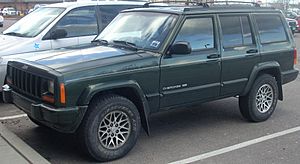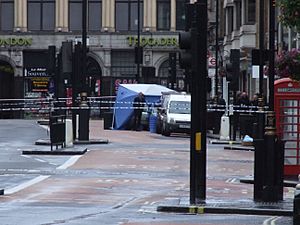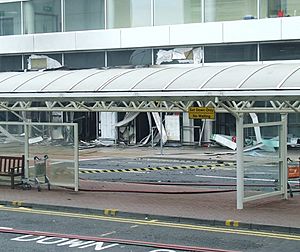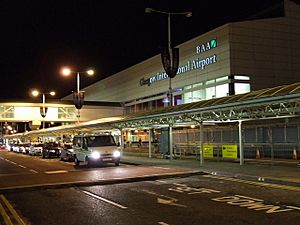2007 Glasgow Airport attack facts for kids
Quick facts for kids Glasgow Airport attack |
|
|---|---|
| Part of Islamic terrorism in Europe | |
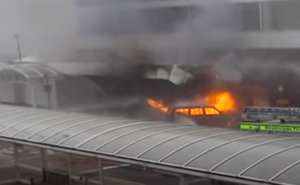
The main terminal building of Glasgow Airport, shortly after the vehicle rammed into the main entrance and caught fire.
|
|
| Location | Glasgow International Airport, Paisley, Renfrewshire, Scotland |
| Date | 30 June 2007 3:11 p.m. – 5:15 p.m. (BST) |
| Target | Passengers at Glasgow Airport |
|
Attack type
|
Vehicle-ramming attack |
| Deaths | 1 (one of the perpetrators) |
|
Non-fatal injuries
|
5 |
| Perpetrators | Bilal Abdullah and Kafeel Ahmed |
| Motive | Islamist terrorism |
The Glasgow Airport attack happened on 30 June 2007. It was a terrorist attack where a Jeep Cherokee, filled with gas canisters, was driven into the glass doors of the Glasgow Airport terminal. The car then caught fire.
The driver was badly burned in the fire. Five other people were hurt, but none seriously. Some people helping the police also got minor injuries. This attack was quickly linked to car bombs found in London the day before.
Police quickly caught both people from the car. Within three days, eight people were arrested in connection with both the Glasgow and London incidents. The two men in the car were identified as Bilal Abdullah, a doctor from Iraq, and Kafeel Ahmed, an engineer from India. Kafeel Ahmed, the driver, later died from his injuries. Bilal Abdullah was found guilty of planning to commit murder and was sent to prison for life.
This was the first terrorist attack in Scotland since the Lockerbie bombing in 1988. It happened just after Gordon Brown became the Prime Minister of the United Kingdom.
Contents
What Happened at Glasgow Airport?
A dark green Jeep Cherokee hit security barriers at the main entrance of Glasgow Airport. Witnesses said the car was going about 30 miles per hour (48 km/h). The vehicle had several petrol containers and propane gas canisters inside.
One person saw flames under the car when it hit the building. Another said the driver seemed to be trying to drive right through the terminal doors. The car had two men inside. Even though the doors were damaged, strong security barriers stopped the car from getting into the terminal. About 4,000 people were inside, so many lives could have been lost.
When the Jeep didn't explode, one man (Bilal Abdullah) threw petrol bombs from the passenger seat. The other man (Kafeel Ahmed) poured petrol on himself and set himself on fire. Police said the car burst into flames when it hit the building. A witness saw a man get out of the car and fight with police, shouting "Allah." This man was Bilal Abdullah.
Another man, Kafeel Ahmed, got out of the car while on fire and fell to the ground. An airport worker, John Smeaton, bravely confronted him. Smeaton later received a medal for his courage.
Right After the Attack
All injured people were taken to the Royal Alexandra Hospital nearby. During the investigation, propane gas canisters were removed from the car. Police confirmed that both men in the car were arrested. One of them, Kafeel Ahmed, was badly burned and later died in the hospital on August 2.
The Jeep was removed early on July 1. Flights then started again, and the airport partly reopened. The hospital's emergency department was briefly closed because of a suspected device on one of the attackers, but it turned out not to be explosive. Bilal Abdullah was held at a high-security police station.
After the attack, the airport was evacuated, and all flights were stopped. Travelers stayed overnight at the Scottish Exhibition and Conference Centre. The main terminal reopened for incoming flights on July 1, and departures started later that morning. Police also arrested two suspects connected to the attack on the M6 motorway.
How Police Investigated the Attack
Police believed the Glasgow attack was linked to the 2007 London car bombs that happened 36 hours earlier. The vehicle in Glasgow reportedly had 60 liters of petrol, gas cylinders, and nails. Experts analyzed the gas cylinders. The head of counter-terrorism said that if the device had exploded, many people could have been seriously hurt or killed.
Reports said the gas cylinders contained propane, like those used for patio heaters. Another car bomb was found in London, a blue Mercedes-Benz. This car had been parked illegally and was later moved to a car pound. Staff there smelled petrol fumes and called the police after hearing about the first bomb.
US officials said three men from Birmingham were identified. One of them might have been linked to Dhiren Barot, who was jailed for planning similar attacks. Police denied claims that they had a "crystal clear" image of a suspect from CCTV footage.
A doctor from India, Mohammed Haneef, was arrested in Australia on July 2. He was trying to fly to India to see his newborn daughter. The case against him later fell apart, and he was released.
On July 1, police carried out a controlled explosion on a car at the Royal Alexandra Hospital car park. The hospital was closed off for a while. It's not clear if there was another device in that car.
Police made more arrests in Paisley on July 2, bringing the total to seven. At least two suspects were doctors working at hospitals in Paisley and Staffordshire. These hospitals were searched by police.
An eighth person was arrested in Australia on July 2, linked to both the Glasgow and London attacks. This person was also a doctor, Mohamed Haneef, who was arrested at Brisbane Airport. His family said he was not involved and was just going home to see his family.
Who Were the Attackers?
Bilal Abdullah and Kafeel Ahmed were identified as the main suspects. Abdullah owned the Jeep. Ahmed was badly burned and died on August 2, 2007.
On December 17, 2009, Abdullah was found guilty of planning murder for both the London and Glasgow incidents. He was sentenced to life in prison. Investigations also looked into if Abdullah and Ahmed were involved in a shooting in India in 2005.
Brave People Who Helped
Many members of the public bravely rushed to help police and confront the attackers.
- Michael Kerr ran towards the attackers, even though he was already safe with his family. He fought with one attacker, lost teeth, and broke his leg.
- Alex McIlveen, a taxi driver, kicked one of the terrorists very hard, tearing a tendon in his own foot.
- Stephen Clarkson tackled Kafeel Ahmed to the ground. This allowed police to arrest him and stop more violence. Mr. Clarkson kept his identity secret for a while.
- Henry Lambie, a retired firefighter, tried to put out the fire in the Jeep. He then used the extinguisher to put out the fire on Bilal Abdullah, helping police arrest him. He said he didn't see himself as a hero.
- Stewart Ferguson, an off-duty policeman, used a fire extinguisher on the burning Kafeel Ahmed. He said it was his duty to help, no matter whose life it was.
- Michael MacDonald, an airport worker, helped people to safety. He then saw a terrorist attacking a policeman and ran to help. He fought with Kafeel Ahmed and helped hold him down for arrest.
- John Smeaton, a baggage handler, was off duty. He heard explosions and ran to help police. He confronted and kicked Kafeel Ahmed. Smeaton also helped drag Michael Kerr to safety. He became well-known after giving interviews.
This incident showed how people can act bravely in a crisis. John Smeaton was awarded the Queen's Gallantry Medal by The Queen in 2008. In 2010, seven others received the Queen's Commendation for Bravery for their actions.
How People Reacted
Scotland's Response

Scotland's First Minister, Alex Salmond, and other Scottish leaders joined a special government meeting. Salmond said that the attacks showed threats exist across the UK. He stated that both the Scottish and UK governments would work together to protect communities.
Kenny MacAskill, the Justice Secretary, said the Glasgow attack was not done by 'home-grown' terrorists.
United Kingdom's Response
Prime Minister Gordon Brown was kept updated. He led a meeting of the government's emergency committee to deal with both the Glasgow attack and the London car bombs. He also spoke with Alex Salmond. Brown told the media that "the British people will stand together." He thanked emergency services and asked the public to stay alert.
International Reactions
- United States: The US Homeland Security Secretary, Michael Chertoff, said they were in close contact with UK officials. US law enforcement was watching the investigations closely.
- United Nations: The Secretary-General of the United Nations Ban Ki-moon condemned the attack. He promised to fight to end global terrorism.
Security Changes
After the attacks, extra police officers were sent to important places like airports, train stations, and bus terminals across the UK. They were told to increase searches. Armed police patrolled major train stations. Security was also increased at large events, like a concert at Wembley Stadium and a music festival.
Security was tightened at the Wimbledon tennis tournament, with concrete barriers used to block cars. Other airports also blocked off roads near their terminals and had more police.
London Luton Airport moved its taxi ranks away from the main building. Blackpool Airport was temporarily closed. Glasgow Prestwick Airport stayed open with armed police. London Heathrow Airport advised people not to bring private cars near terminals.
On June 30, Liverpool John Lennon Airport closed for eight hours to remove a suspicious vehicle. Pearson International Airport in Canada also increased security.
In the US, airport security was tightened, but the alert level stayed the same. US officials said there was no specific threat to the United States. An article claimed US officials knew about possible attacks in Scotland and the Czech Republic two weeks before, leading to air marshals on flights.
On July 1, a terminal at John F. Kennedy International Airport in New York was evacuated due to a suspicious package.
What Happened After the Attack?
On July 1, the police announced that the airport would slowly reopen. The first flight left around 9:00 AM. Police searched several houses nearby. The main terminal building reopened later that day. The lanes directly in front of the terminal are now blocked off to most vehicles, only allowing authorized public transport.
Police in Liverpool arrested one man, and two others were arrested on the M6 motorway. Several addresses in Liverpool were searched.
Mohammad Sarwar, a local Member of Parliament, reported that threats were made against the Muslim community in Scotland after the incident.
In 2008, a leader of a terrorist group in Iraq claimed his group carried out the Glasgow attack. Evidence, like a text message and a will left by one of the bombers, supported this claim.
Other Airports' Security
Airports like Edinburgh, Aberdeen, Cardiff, Belfast, Birmingham, Manchester and Newcastle all put measures in place to prevent similar attacks. They blocked off roads leading to and in front of their terminal buildings.
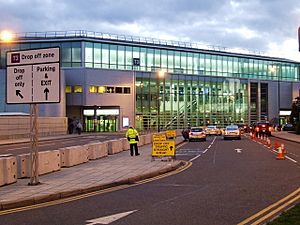
Asking for Information
On July 1, police asked for anyone with information about the dark green Jeep Cherokee (registration L808 RDT) to come forward. They also asked for any photos or videos taken of the burning vehicle.
Public Feelings
This attack, and the earlier attempt in London, were not very successful. Because of this, the public's reaction was often a mix of amusement and fear.
The baggage handler John Smeaton became a small celebrity. He was awarded the Queen's Gallantry Medal for his brave actions.
See also


